PDF Model Essays 3, Developing your writing skills, Betty Kirkpatrick, Terry Bell
Tin đăng trong ' Kỹ năng viết | Writing skills, composing ' bởi admin , Cập nhật cuối: 23/11/2021 .
- betty kirkpatrick
- model essays
- model essays 3
- writing skills

admin Administrator Staff Member
Model Essays 3, Developing your writing skills, Betty Kirkpatrick, Terry Bell Đây là bộ sách gồm 3 cuốn được biên soạn nhằm giúp người học hiểu cách bố cục một bài văn hay. Qua việc đọc và phân tích các bài luận mẫu, học viên sẽ có được ý tưởng và thông tin liên quan đến các chủ đề. Người học cũng sẽ dần quen với các kỹ thuật viết văn hay. Sau mỗi bài luận là phần từ vựng, giải thích các từ khó trong bài. Vài nét về tác giả Betty Kirkpatrick, cử nhân Đại học Edinburgh, là một biên tập viên, người xuất bản sách, và tác giả viết sách tham khảo tiếng Anh xuất sắc và nhiều kinh nghiệm. Bà là người biên tập Chambers Twentieth Century Dictionary và Rogers Thesaurus. Hiện nay bà chủ yếu viết cho Learners Publishing. Terry Bell tốt nghiệp Đại học Wales, Vương quốc Anh. óng đã dạy tiếng Anh nhiều năm cho những người nói các ngôn ngữ khác và là tác giả của nhiều tài liệu hỗ trợ giảng dạy tiếng Anh. Sự nghiệp của ông phần lớn gắn bó với CfBT (Centre for British Teachers) ở châu Âu và châu Á, và có một khoảng thời gian ngắn giảng dạy tại miền tây nước Úc. óng đã tham gia viết giáo trình và gần đây ông đã phối hợp các tài liệu giảng dạy đa phương tiện bằng tiếng Anh cho môn Khoa học ở bậc Tiểu học.
- Speak now 2, Communicate with confidence, Jack C. Richards, David Bohlke, Carmella Lieske, Oxford - 22/11/2021
- Achievers B1+ Workbook, Claire Thacker, Richmond - 22/11/2021
- blog làm seo với blogspot.com - 22/11/2021
- thanh toán online với shoppy.gg - 22/11/2021
- Bí quyết vẽ tĩnh vật, Huỳnh Phạm Hương Trang - 22/11/2021
- Model Essays, Preparing for Composition in the PSLE, Mohd Anwari - 23/11/2021
- 50 bài luyện dịch Việt Anh, trình độ B, C và Toefl, Trần Văn Diệm (biên soạn) - 23/11/2021
- Sổ tay Anh Mỹ đối chiếu và các từ ngữ tiếng Mỹ thông dụng nhất, Nguyễn Tri Niệm - 23/11/2021
- Tổng tập đề thi Olympic 30 tháng 4 Tiếng Anh 11, từ 2014 đến 2018, Ban tổ chức kì thi - 23/11/2021
- Đột phá từ vựng Hán Ngữ Quốc Tế HSK cấp độ A, Vương Tiểu Ninh, Vương Khương Hải - 23/11/2021
- Time Zones Starter Third Edition (3e) Nicholas Beare - Hôm nay lúc 10:49
- Kid's box 5 Updated edition Presentation Plus - Hôm qua, lúc 00:20
- Sổ tay từ vựng tiếng Trung giao tiếp, Sơn Dương - Thứ ba lúc 20:40
- Tiếng Trung giao tiếp thần tốc tập 4, Sơn Dương - Thứ ba lúc 20:39
- Tiếng Trung giao tiếp thần tốc tập 3, Sơn Dương - Thứ ba lúc 20:37
- ENGLISH THEMATIC COMPOSITION WRITING - 09/05/2018
- Academic Writing Samples Tests 1-10 - 27/05/2018
- ADVANCED MATERIALS FOR IELTS WRITING - 27/05/2018
- IELTS Writing Task 1 Sample - Academic - 27/05/2018
- First steps in academic writing - Level 2 | Pearson Longman - 27/05/2018
Chia sẻ trang này
- Chưa, tôi muốn đăng ký mới với mật khẩu sau:
- Vâng, Mật khẩu của tôi là:
- Bạn đã quên mật khẩu?

- Chỉ tìm trong tiêu đề
Giãn cách tên bằng dấu phẩy(,).
- Chỉ tìm trong tin đăng này
- Hiển thị kết quả dạng Tin đăng
Tìm kiếm hữu ích
- Recent Posts
- English Ebooks 08 678 30 339 [email protected]

- Bảng giá chung
- Kho sách theo nhóm
- Sách Ebook tải miễn phí
- Đăng ký dùng sách Thư viện
- Vào Thư Viện Sách Mềm
- Vào INTERBOOKS-LIBRARY dự phòng
- Ngôn ngữ Anh
- Ngôn ngữ Anh-Mỹ
- Tiếng Anh Mầm non
- Tiếng Anh Tiểu học
- Tiếng Anh Trung học
- Tiếng Anh tổng quát
- Tiếng Anh giao tiếp
- Ngữ pháp tiếng Anh
- Giáo trình IELTS
- Luyện thi Quốc tế
- Sách Toán tiếng Anh
- Khoa học-Lịch sử-Địa lý-Vẽ
- Giáo trình trong nước
- Giáo trình Trường Quốc tế
- Truyện đọc tiếng Anh
- Từ điển tiếng Anh
- Phần mềm tiếng Anh
- Tiếng Anh chuyên ngành
- Sách tiếng Anh trong nước
- Sách NXB Cambridge
- Sách NXB Oxford
- Sách NXB Pearson
- Sách NXB Macmillan
- Sách NXB McGraw-Hill
- Sách NXB Collins
- Sách NXB Usborne
- Sách NXB Scholastic
- Sách NXB Harcourt
- Sách NXB MM Publications
- Sách NXB Express Publishing
- Sách NXB Learners Publishing
- Sách NXB Compass Publishing
- Sách NXB Build&Grow (N.E.)
- Sách NXB NAT GEO-Cengage
- Sách NXB Dorling Kindersley (DK)
- Kho sách Audiobook
- Xem sách tích hợp (online)
- Đăng ký dùng sách iTools trực tuyến
- Đặt mua sách iTools và thanh toán
- Kho phần mềm tiếng Anh (offline)
- Bài giảng khối Mầm non
- Bài giảng khối Tiểu học
- Bài giảng khối Trung học
- Powerpoint Games
- Liên kết học Tiếng Anh
- All Các sản phẩm đặc sắc Giáo trình trường Quốc tế Kho sách Audiobook Kho sách iTools của Interbooks Năm phát hành Nhóm sách trong Thư viện Nhóm sách Trung tâm Phần mềm giảng dạy theo sách Phần mềm tiếng Anh Sách giáo trình IELTS Sách Khoa học-Lịch sử-Vẽ Sách luyện Nghe-Nói-Đọc-Viết Sách luyện thi Quốc tế Sách mới có Sách ngôn ngữ Anh-Anh Sách ngôn ngữ Anh-Mỹ Sách ngữ pháp tiếng Anh Sách NXB Cambridge Sách NXB Compass Publishing Sách NXB khác Sách NXB Macmillan Sách NXB NAT GEO-Cengage Sách NXB Oxford Sách NXB Pearson Sách NXB Richmond Sách tải về miễn phí Sách tiếng Anh chuyên ngành Sách tiếng Anh giao tiếp Sách tiếng Anh Mầm non Sách tiếng Anh Tiểu học Sách tiếng Anh Trung học Sách Toán tiếng Anh Sách truyện đọc tiếng Anh Slides bài giảng Tiếng Anh trong nước Top 10 sản phẩm nổi bật Từ điển tiếng Anh Search for:

Model Essays (trọn bộ)
- Description
Bộ sách luyện viết gồm 3 tập rất hay với các phần hướng dẫn bạn tập viết các bài luận từ cơ bản đến nâng cao, viết đúng ngữ pháp rất hữu ích cho Giáo viên và Học sinh. Đây cũng là bộ sách gợi ý cho các Học sinh luyện phần thi Viết trên IELTS.
- Model Essays 1 – Showing you the Basics
- Model Essays 2 – Preparing you for Writing
- Model Essays 3 – Developing your Writing Skills
Related products

Nhóm sách trong Thư viện
English Collocations in Use (Cambridge)

Business Vocabulary in Use (Cambridge)
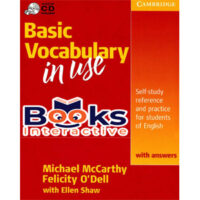
Basic Vocabulary in Use (Cambridge)

Skillful Reading&Writing 1st edition (Macmillan)

Sách mới có
Grammar and Beyond (Cambridge)
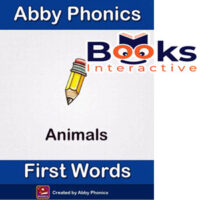
Animals First Words (Abby Phonics)

Get Ready for Grades (trọn bộ)

Luyện thi CEFR
Think (Cambridge)
- Lead Your Pathways

Username or email address *
Password *
Remember me Log in
Lost your password?
- Writing, Research & Publishing Guides
Sorry, there was a problem.

Download the free Kindle app and start reading Kindle books instantly on your smartphone, tablet, or computer - no Kindle device required .
Read instantly on your browser with Kindle for Web.
Using your mobile phone camera - scan the code below and download the Kindle app.

Image Unavailable

- To view this video download Flash Player
Short Takes: Model Essays for Composition 11th Edition
- ISBN-10 0321923731
- ISBN-13 978-0321923738
- Edition 11th
- Publisher Longman
- Publication date February 10, 2013
- Language English
- Dimensions 5.5 x 0.7 x 8.5 inches
- Print length 288 pages
- See all details
Product details
- Publisher : Longman; 11th edition (February 10, 2013)
- Language : English
- Paperback : 288 pages
- ISBN-10 : 0321923731
- ISBN-13 : 978-0321923738
- Item Weight : 12.8 ounces
- Dimensions : 5.5 x 0.7 x 8.5 inches
- #3,108 in Creative Writing & Composition
- #21,038 in Fiction Writing Reference (Books)
- #388,539 in Unknown
Customer reviews
| 3 star | 0% | |
| 2 star | 0% | |
| 1 star | 0% |
Customer Reviews, including Product Star Ratings help customers to learn more about the product and decide whether it is the right product for them.
To calculate the overall star rating and percentage breakdown by star, we don’t use a simple average. Instead, our system considers things like how recent a review is and if the reviewer bought the item on Amazon. It also analyzed reviews to verify trustworthiness.
- Sort reviews by Top reviews Most recent Top reviews
Top review from the United States
There was a problem filtering reviews right now. please try again later..
- About Amazon
- Investor Relations
- Amazon Devices
- Amazon Science
- Sell products on Amazon
- Sell on Amazon Business
- Sell apps on Amazon
- Become an Affiliate
- Advertise Your Products
- Self-Publish with Us
- Host an Amazon Hub
- › See More Make Money with Us
- Amazon Business Card
- Shop with Points
- Reload Your Balance
- Amazon Currency Converter
- Amazon and COVID-19
- Your Account
- Your Orders
- Shipping Rates & Policies
- Returns & Replacements
- Manage Your Content and Devices
- Conditions of Use
- Privacy Notice
- Consumer Health Data Privacy Disclosure
- Your Ads Privacy Choices
- Quick Upload
- Contact Us
- FAQ
- Help Document
- Help Document
WRITE IT RIGHT 2020 MODEL ESSAYS FOR PT3
- PENERBITAN PELANGI SDN BHD
- http://anyflip.com/ekbvw/vngp/
Related Publications
PELANGI Write it Right EF1oSr2mS3MAYOSDPEFTLO3R Step-by-step Word Bank & Tips & Based on guide for Idioms for Techniques the 2019 different Vocab Enrichment for each PT3 essay types section format Write it Right MODEL ESSAYS FOR PT3 1For2m 3 PELANGI Penerbitan Pelangi Sdn. Bhd. (89120-H) PENERBITAN PELANGI SDN. BHD. (89120-H) Head Office: 66, Jalan Pingai, Taman Pelangi, 80400 Johor Bahru, Johor Darul Takzim, Malaysia. Tel: 07-331 6288 Fax: 07-332 9201 E-mail: [email protected] Sales Office: Lot 8, Jalan P10/10, Kawasan Perusahaan Bangi, Bandar Baru Bangi, 43650 Bangi, Selangor Darul Ehsan, Malaysia. Tel: 03-8922 3993 Fax: 03-8926 1223 / 8920 2366 Enquiry: [email protected] © Penerbitan Pelangi Sdn. Bhd. 2020 All rights reserved. No part of this book may be reproduced, stored in a retrieval system, or transmitted in any form or by any means, electronic, photocopying, mechanical, recording or otherwise, without the prior permission of Penerbitan Pelangi Sdn. Bhd. ISBN: 978-967-2353-16-4 First Published 2020 Printed in Malaysia by The Commercial Press Sdn. Bhd. Lot 8, Jalan P10/10, Kawasan Perusahaan Bangi, Bandar Baru Bangi, 43650 Bangi, Selangor Darul Ehsan. Please log on to www.ePelangi.com/errata for up-to-date adjustments to the contents of the book (where applicable). English PT3 Common Mistakes in Writing Common Mistakes in Writing Poor Structure • A well-organised essay must have an introduction, body and conclusion. The first paragraph must give an introduction to the main topic of the essay. The body contains the main points of the essays and should comprise 3 to 5 paragraphs. The final paragraph should provide a suitable conclusion to the topic of discussion. Unorganised • The essay is haphazard. Before starting the essay, a draft must be prepared on the main points to be discussed. This will ensure that ideas are presented in an organised manner. Beating around the bush • Get to the point. You must keep to the word limit and write within the given frame of time. Therefore, an essay must not contain excessive elaboration or irrelevant information. Spelling • Pay attention to spelling as errors will result in deduction of marks. (Refer to Page 398 for list of commonly misspelled words). Incorrect spelling may also alter the meaning of your sentence. Punctuation • Use appropriate punctuation marks as a guide to how the examiner should read the sentences. The most common mistake is joining two sentences with a comma instead of a full stop. Another common error is the use of the comma before the word ‘and’. Improper Paragraphs • The most common mistake is to present two or more main ideas in a single paragraph. A paragraph should contain a topic sentence, which is the main idea of the paragraph. The remaining sentences in the paragraphs should contain information to support the central idea. Each main idea should be presented in an individual paragraph. Format • Read the question correctly and determine the appropriate format to be used – letter (formal or informal), speech, reports, narrative essays, etc. 393 English PT3 Common Mistakes in Writing Grammar Mistakes • Decide whether to use the present or past tense before start writing. Once a choice has been made, you must be consistent. Remember that every sentence needs a subject and a verb. Also pay attention to Subject-Verb Agreement. Singular subjects take singular verbs and plural subjects take plural verbs. Vocabulary • Avoid repeating the same words and never use slang. Do not use words which you are unfamiliar with as they may change the meaning of your sentence. Plagiarism • Plagiarism is an act of fraud. If you have used someone else’s work or ideas, you must acknowledge the source. Essay Writing Checklist Execution of task • Have you answered the question? • Have you used all the points given? • Have you elaborated on all the points? Organisation of task • Do you have an interesting introduction that will capture your examiner’s attention? • Does each paragraph have a main idea? • Does your essay have an appropriate conclusion that sums up the points in your essay? • Have you fulfilled the word requirement? Language • Are your sentences grammatically correct? • Have you used the right tenses? • Have you used interesting phrases and appropriate vocabulary? • Have you used the correct punctuation? 394 English PT3 Phrasal Verbs Phrasal Verbs A phrasal verb is a verb plus a preposition which creates a different meaning from the original verb. Below are some phrasal verbs. Phrasal Meaning Example Verb 1. account explain the • The Treasurer could not account for the for cause for shortage of money in the bank. → The Treasurer could not explain the cause for the shortage of money in the bank. 2. back out to withdraw • John promised to help but he backed out at the last minute. → John promised to help but he withdrew at the last minute. 3. keep informed • The newspapers keep me abreast on local and abreast global issues. → The newspapers keep me informed on local and global issues. 4. take to exploit • We should not take advantage of his advantage generosity just because he is rich. of → We should not exploit his generosity just because he is rich. 5. give up surrender • Don’t give up – you can still meet the deadline. → Don’t surrender – you can still meet the deadline. 6. back to give way or • Although Sam was right, he decided to back down retreat down when the argument escalated. → Although Sam was right, he decided to give way when the argument escalated. 7. pass out lose • The injured athlete finished the run and consciousness passed out at the finish line. → The injured athlete finished the run and lost consciousness at the finish line. 395 English PT3 Phrasal Verbs 8. go back to fail to keep • It is not right to go back upon your word upon to one’s word once you have made a promise. 9. bear with be patient → It is not right to fail to keep to your word once to strengthen you have made a promise. 10. beef up 11. blow over subside • Please bear with me as I need more time to 12. bent on determined decide which house to purchase. 13. lift a to do work to expand → Please be patient as I need more time to decide finger succumb to which house to purchase. 14. branch emotion • He beefed up his speech by adding more facts out demolish and figures. 15. break → He strengthened his speech by adding more down facts and figures. 16. pull down • Don’t worry, his anger will soon blow over. → Don’t worry, his anger will soon subside. • She is bent on taking part in the beauty contest. → She is determined to take part in the beauty contest. • The lazy servant was fired for not lifting a finger in the house. → The lazy servant was fired for not doing any work in the house. • He decided to branch out and take his business overseas. → He decided to expand and take his business overseas. • If you start scolding her again she will break down. → If you start scolding her again she will succumb to emotion. • All the houses in the squatter area will be pulled down by December. → All the houses in the squatter area will be demolished by December. 396 English PT3 Phrasal Verbs 17. call off cancel • The hiking trip will be called off if it rains. 18. keep up be on par → The hiking trip will be cancelled if it rains. 19. put off 20. look with • You must keep up with the other Scouts if to delay you want to earn a badge. after to take care 21. call on → You must be on par with the other Scouts if 22. check on of you want to earn a badge. 23. chip in to visit 24. cave in to investigate • Do not put off until tomorrow what you can 25. draw to contribute accomplish today. collapse upon rely on → Do not delay until tomorrow what you can accomplish today. • She was charged with looking after her younger siblings. → She was charged with taking care of her younger siblings. • Last Sunday I decided to call on an old friend that I had not seen in a while. → Last Sunday I decided to visit an old friend that I had not seen in a while. • The police came to check on the loud noise coming from the bungalow. → The police came to investigate the loud noise coming from the bungalow. • We appreciate any sum you can chip in for the school fund-raiser. → We appreciate any sum you can contribute for the school fund-raiser. • The roof of the house caved in during the thunderstorm. → The roof of the house collapsed during the thunderstorm. • The hikers had to draw upon their common sense to survive in the jungle. → The hikers had to rely on their common sense to survive in the jungle. 397 English PT3 Commonly Misspelled Words Commonly Misspelled Words Correct Spelling Wrong Spelling Correct Spelling Wrong Spelling absence absense, absance business bisness acceptable acceptible calendar calender accidentally accidently camouflage camoflage accommodate accomodate, category catagory acommodate cemetery cemetary acknowlege, acknowledge aknowledge changeable changable achieve acheive column colum adultery adultary committed commited acquaintance aquaintance consensus concensus advisable adviseable definite definit alcohol alchohol desperate desparate algorithm algorythm embarrass embarass almost allmost disappiont disapoint a lot alot exceed excede amateur amatuer fascinating facinating amend ammend fluorescent flourescent annually annualy harass harrass arctic artic hierarchy heirarchy atheist athiest imaginary imaginery beginning begining imitate immitate burglar burgler imitation immitation 398 English PT3 Commonly Misspelled Words Correct Spelling Wrong Spelling Correct Spelling Wrong Spelling immediately imediately omission ommision incidentally incidently outrageous outragous independent independant parliament parliment indispensable indispensible pastime passtime inoculate innoculate perseverance perseverence irrelevant irrelevent personnel personel irritable irritible plagiarize plagarize jewellery jewellry playwright playright, playwrite liaison liason maintenance maintainance possession posession medieval medival potatoes potatos memento momento precede preceed millennium milennium privilege privelege miniature miniture pronunciation pronounciation minuscule miniscule publicly publically mischievous mischievious quarantine quarentine misspell mispell queue que necessary neccessary questionnaire questionnaire noticeable noticable receive recieve occasion occassion receipt reciept omission ommision recommend reccommend original orginal referred refered occurrence occurence reference refrence occurred occured relevant relevent 399 English PT3 Commonly Misspelled Words Correct Spelling Wrong Spelling Correct Spelling Wrong Spelling religious religous tomatoes tomatos repetition repetition tomorrow tommorrow restaurant restaraunt tyranny tyrany rhythm rythm upholstery upholstry secretary secretery until untill seize sieze vacuum vaccuum separate seperate vehicle vehical sergeant sargent weird wierd similar similiar welfare wellfare supersede supercede withhold withold surprise suprise writing writting 400 Write it Right JC107220 EF1oSr2mS3MAYOSDPEFTLO3R This book is designed to help MODEL ESSAYS FOR PT3 students improve their writing skills. From the interpretation of the question to the planning and writing process, the reader is guided step by step in the Model Essays. Each Model Essay illustrates the process of developing ideas into an essay by putting into practice simple yet invaluable principles of essay writing. This book also includes the latest PT3 format of the Writing Section, which is divided into Short Communicative Message and Note Expansion. Though aimed at Form 1 – Form 3 students, this book is also suitable for anyone who wants to write well. W.M: RM18.95 / E.M: RM18.95 JC107220 ISBN: 978-967-2353-16-4
- Open access
- Published: 12 December 2022
Improving L2 learners’ IELTS task 2 writing: the role of model essays and noticing hypothesis
- Long Quoc Nguyen ORCID: orcid.org/0000-0002-4674-7199 1 &
- Ha Van Le 1
Language Testing in Asia volume 12 , Article number: 58 ( 2022 ) Cite this article
4014 Accesses
2 Citations
3 Altmetric
Metrics details
Achieving a sufficient IELTS band score for academic purposes has been a major goal of many L2 learners around the world, especially those in Asia. However, IELTS writing scores were consistently reported to be the lowest when compared to the scores in speaking, reading, and listening. Despite a growing body of research in IELTS writing, little focused on the role of model essays and noticing hypotheses. The present study aimed to fill in this gap by examining whether or not the implementation of both noticing hypothesis and model essays had a discernible influence on learners’ IELTS task 2 writing. To reach this goal, a quasi-experimental design including a pretest and a posttest was conducted with the voluntary participation of 52 undergraduates. These participants were divided into two groups: control group (CG, n = 25), learning in the conventional method (peer feedback and teacher feedback), and experimental group (EG, n = 27), using the noticing-model essays method. Following this, semi-structured interviews were performed to gain insights into the quantitative data. The results from this mixed-methods approach showed that there were significant gains in the overall performance and in the lexical resources subscale in the EG while no considerable changes were observed in the CG. Additionally, the other subscales (task response, grammatical range and accuracy, and cohesion-coherence) did not witness any significant differences between the two groups. Several pedagogical implications and recommendations for future research, especially in the Asian context, were also discussed.
Introduction
Of all the four skills of English, writing has been deemed to be the most challenging for second language (L2) learners. This is evident via the international statistics of IELTS (International English Language Testing System), which demonstrated that the average band score in writing, an academic module, was the lowest when compared to that in the other three skills (Test taker performance 2021, n.d. ). In particular, the scores for writing, speaking, reading, and listening in the year of 2021 were 5.92, 6.14, 6.26, and 6.50 (out of 9.0), respectively. To enhance L2 learners’ writing, corrective feedback (i.e., teacher feedback and peer feedback) has been widely researched and implemented (e.g., Hyland & Hyland, 2006 ; Allen and Mills, 2016 ; Yu et al., 2016 ; Hentasmaka & Cahyono, 2021 ). Effective as it has been shown, this kind of feedback does have several drawbacks. First, teachers’ or peers’ focus does not always match learners’ actual focus, which might lead to unfulfilled expectations (e.g., Izumi et al., 1999 ; Long & Robinson, 1998 ). Second, teacher feedback is not always available as teachers have to undertake a heavy workload, especially in large classes (Lee, 2003 ). Additionally, frequent and intensive exposure to input (feedback from teachers or peers) does not necessarily equate with native-like performances (Swain, 1985 ).
Consequently, there has been a shift in how L2 learners receive adequate feedback for their writing, which is to utilize output, noticing, and native speakers’ models. This technique has been demonstrated to be beneficial to learners’ L2 development (Eschholz, 1980 ; Smagorinsky, 1992a , 1992b ; Lynch, 2009 ), and to be even “more helpful to the learner than error correction” (Qi & Lapkin, 2001 , p. 286). Recent works have also confirmed the effectiveness of the noticing-model combination (Hanaoka, 2006 , 2007 ; Hanaoka & Izumi, 2012 ; Khezrlou, 2021 ). In these studies, after learners composed their essays (output), they compared what they wrote with what native speakers did, identified the gaps or problems (noticing), and adopted the new information as input. Nonetheless, IELTS materials were not employed in such research, which warrants further exploration.
The method of using model essays together with noticing as a feedback instrument for learners’ IELTS writing has attracted increased, albeit still limited, interest from researchers (e.g., Bagheri & Zare, 2009 ; Qi & Lapkin, 2001 ; Tieu & Baker, 2022 ). These studies showed that learners who revised their essays based on this method achieved better band scores in writing compared to those receiving corrective feedback from teachers and peers. Prominent as deemed, there were still a few limitations in these works (i.e., only using qualitative data, unclear procedure, or low reliability) that rendered the results and findings questionable. Additionally, in the context of Asia, especially in Vietnam, except for Tieu and Baker’s study (2022), there seems to be an absence of sound research on the issue of noticing-model essays, which necessitates further investigation.
Literature review
Ielts academic writing.
According to the book IELTS Academic 17 ( 2022 ), the writing section consists of two tasks, the first one about describing a given diagram in at least 150 words (about 20 min) and the second one about composing an essay (advantages-disadvantages, opinions, causes-effects, causes-solutions, and both view discussions) in at least 250 words (about 40 min). While task 1 aims to evaluate test-takers’ ability to compare, contrast, organize and present data, task 2 focuses on their capability to respond to a given issue of various academic topics (IELTS Academic 17, 2022 ). The present study only concentrated on the second task as this part is about essay writing, and it weighs two times more than the first one.
In the public version of band descriptors, IELTS writing task 2 is marked based on four criteria, including task response (content), cohesion and coherence (unity and organization), grammatical range and accuracy (grammar), and lexical resources (vocabulary). The score is given on a scale of 9.0, with 0 being the lowest and 9.0 being the highest for each marking criterion. The overall grade is the average of the four subscores, rounded to .0 or .5. The detailed descriptions of the writing rubrics can be found in Appendix 1 .
Output, noticing, and language models in SLA
In second language acquisition (SLA), the output hypothesis was proposed and primarily discussed by Swain ( 1985 , 1995 , 1997 , 2005 ), comprising three key elements: noticing, hypothesis testing, and metalinguistic awareness. The first function occurs when learners produce the target language from which they notice the problems preventing them from generating the intended meaning. This gap motivates learners to pay close attention to the required means of expressions that they need in order to convey the message successfully as intended. The second function is about learners’ trying out the information they have noticed earlier. Feedback is vital in this stage as they need to have something against which they can test their hypothesis (Swain, 1997 ). The last element is metalinguistic awareness which refers to learners’ reflection of the new information. They can do this by using it in contexts, which helps raise their awareness of the newly recognized language aspects.
There has been a considerable emphasis on learners’ attention and awareness as important elements (Swain, 1985 ; Schmidt & Frota, 1986 ; Swain and Lapkin, 1995 ; Schmidt, 2001 ). The credit for the noticing hypothesis was given to Schmidth ( 1983 ), who claimed that learners needed to be aware of their language use and test it against native speakers’ output. However, it was not until 2010 that he posited the official definition of this theory: “Input does not become intake for language learning unless it is noticed, that is, consciously registered” (p. 271). This definition highlighted the importance of noticing as the critical element for intake, which gained support from many linguists (e.g., Leow, 2018 ; Richards & Schmidt, 2013 ).
Negative input, also a kind of comprehensible input, was emphasized by Swain ( 1985 ), which linked input, noticing, and output together. As learners finished producing the language (output), they recognized (noticing) there were issues in their speaking or writing (gaps). Then, they compared their output with native speakers’ (negative input) and modified their language to concisely express their intended meanings (Rutherford & Smith, 1985 ; Swain, 1985 ). It can be seen that there is a general consensus among many researchers on the significance of the noticing hypothesis in SLA.
Although output, noticing, and native speakers’ models are vitally crucial to SLA, little research (Hanaoka, 2006 , 2007 ; Hanaoka & Izumi, 2012 ; Khezrlou, 2021 ) has been conducted to explore their roles. In Hanaoka’s work (2006), which explored the effectiveness of native speakers’ models in enhancing noticing in L2 writing, the author employed a four-stage writing task including output, comparison, and two revisions with the participation of 37 Japanese learners at a women’s university. The participants were asked to write a narrative based on the given pictures and noted down any problems they had during their task (stage 1), compared their narratives with native speakers, and took notes on any linguistic features or differences they noticed (stage 2), rewrote their original text (stage 3), and rewrote it one more time after two months (stage 4). The results showed that models, as a feedback tool, played a significant role in promoting learners to notice the solutions to the problems they had and incorporate these features in their revisions. Using the same dataset, Hanaoka ( 2007 ) explored another aspect of output, noticing, and writing: learners’ attention to forms. The author reported that the participants overwhelmingly noticed lexical features (92.4%), found solutions to their problems, and implemented these elements in their revised versions.
Hanaoka and Izumi ( 2012 ) investigated how noticing and two feedback instruments (models and reformulations) helped solve learners’ overt and covert problems in L2 writing. The authors conducted the study via a multi-stage writing task with the participation of 38 Japanese EFL university freshmen (intermediate level of English). In the first stage, the students were required to write a story (a narrative paragraph of six sentences) based on picture prompts and take notes on any problems they had. In stage 2 (1 week later), they were given a model and a reformulated version of their writing (all written or modified by native speakers) and were asked to compare as well as note down any linguistic features or differences they noticed. In stage 3, they rewrote their narratives using the same pictures. It was found that the participants recognized solutions to both overt and covert problems and incorporated these new features in their rewritten paragraphs. Another finding was that while the models dealt with both overt and covert problems quite equally, the reformulations mostly addressed the overt issues.
The studies by Hanaoka ( 2006 , 2007 ), as well as Hanaoka and Izumi ( 2012 ), highlighted the significant role of noticing and models in L2 writing, yet the findings seemed to be limited to revisions only. In other words, whether the same effect could be found when a new task is applied remains unknown. Khezrlou ( 2021 ) addressed this issue by exploring the effects of models between output of the same oral narrative task and the new task. Adopting a quasi-experimental design, the author divided 71 advanced beginner English as a foreign language (EFL) students into three groups: task repetition and oral modeling (group 1), task repetition and writing model (group 2), and task repetition with no modeling (group 3, control group). All groups took an additional oral narrative task 3 days later (after the treatment). The results demonstrated that group 1 and group 2 outperformed group 3 in terms of complexity, accuracy as well as fluency, and that group 2 (with writing modeling) performed better than group 1 (with oral modeling). It was also reported that while the number of error-free clauses remained unchanged, the number of accurate verb forms increased in task repetition with writing modeling and declined in the new task. Khezrlou ( 2021 ) concluded that models were effective in providing learners with linguistic features and also in expanding their language acquisition. However, Khezrlou’s research focused only on speaking; the effect of noticing and models on new writing tasks remains unanswered.
Overall, the extant literature on output, noticing, and models in SLA demonstrates that native-speakers’ modeling plays a significant role in promoting learners’ L2 development. Nonetheless, such literature is still limited, especially in writing. Although Hanaoka ( 2006 , 2007 ), as well as Hanaoka and Izumi ( 2012 ), conducted studies on this skill, they neither used IELTS materials, which are far more complex than narratives, nor tested the effect of output, noticing, and models in a new task. These gaps necessitate further research.
Empirical research on noticing-model essays in IELTS task 2 writing
Most studies about the combination of native speakers’ model essays and noticing in IELTS writing mainly employed descriptive analysis (Abe, 2009 ) or theme analysis (Baleghizadeh & Arab, 2011 ). Few researched this issue using experimental design, and even very few seemed to employ a mixed-methods approach to gain insightful data. In these studies, however, several limitations need to be addressed for higher validity and reliability.
Abe ( 2009 ) conducted an exploratory study on what language aspects Japanese L2 writers noticed when comparing their own essays with the model ones. After listening to the participants’ sharing (via speaking) and analyzing the frequencies of five categories (form, content, lexical, discourse, and others), the authors found that learners paid the most attention to lexical items. However, the sample size was only seven, and the participants’ noticing did not guarantee that they would write better. Therefore, it is still unclear whether the method of noticing-model essays is effective in improving learners’ L2 writing.
Bagheri and Zare ( 2009 ) explored the topic further, performing an experimental study with 65 Iranian university students divided into three groups: group A (intermediate learners, the baseline), Group B (intermediate learners, with model essays), group C (advanced learners, with model essays). After the treatment, the experimental groups (groups B and C) achieved higher scores in IELTS task 2 writing, outperforming the control group. However, Jafary ( 2014 ) conducted a similar study yet found that the experimental groups only did better in two aspects (task response and lexical resources). These two studies did not investigate whether there was a significant difference in each marking criterion of IELTS writing task 2 between the control and the experimental groups, only exploring learners’ perspectives on these aspects.
Recent research on noticing-model essays in IELTS task 2 writing in the context of Vietnam was performed by Tieu and Baker ( 2022 ). In a quasi-experimental design, they divided 33 undergraduates of intermediate level into two groups: the control group ( n = 14) and the experimental group ( n = 19). After the treatment, it was found that the experimental group who were exposed to model essays and noticing scored higher in all four aspects when compared to the control group. The posttest scores of the participants in the baseline group were even lower, albeit insignificant than their scores in the pretest. These results were, nevertheless, questionable because of three problems. First, the treatment only lasted 4 days, which seemed insufficient for such significant linguistic gains in the four criteria of IELTS task 2 writing. Second, the posttest was delayed for several months due to the COVID-19 pandemic, which might have altered the treatment in some ways as learners could have been exposed to other kinds of input or output. Third, the authors used t tests to compare the means, yet no normality tests were reported, raising doubts about the validity.
Consequently, further research is needed, especially with a mixed-methods approach, to alleviate the mixed findings and generate more reliable outcomes. This present study aims to fill in the aforementioned gaps by focusing on (a) whether model essays combined with noticing hypotheses improve learners’ overall scores in IELTS task 2 writing, (b) which of the four aspects (task response, lexical resources, grammatical range and accuracy, cohesion, and coherence) witnesses significant gains via the use of this feedback instrument. Two following research questions were formulated:
Does using noticing-model essays as a kind of feedback improve L2 learners’ overall scores in IELTS task 2 writing more than the conventional instructional method?
Does using noticing-model essays as a kind of feedback improve L2 learners’ scores in the four marking criteria of IELTS task 2 writing more than the conventional instructional method?
It is significant to conduct this research for several reasons. First, it contributes further to the literature on using model essays and noticing as a feedback instrument in improving learners’ output in IELTS task 2 writing, shedding light on the doubts in previous studies. Second, it helps ESL/EFL teachers and students, especially those in Asia, determine whether to employ this technique or not in IELTS preparation. In addition, it leads to a new path of research related to the incorporation of model output and noticing to enhance other skills of L2 learners.
Methodology
Participants.
The participants in the present study were 52 EFL Vietnamese undergraduates aged 18–19, majoring in Software Engineering from two different classes. They took IELTS courses (listening-speaking and reading-writing) to achieve a required IELTS overall band score (6.0 out of 9.0) before officially enrolling in their specialized programs. They took the IELTS courses for 7 weeks, 6 days a week, from Monday to Saturday, 3 h a day. Every Monday, Wednesday, and Friday, they were trained the listening and speaking skills, while the other days were spent on reading and writing. Their English proficiency at the time of research, based on the placement test designed by Pearson Education (Ascher & Saslow, 2022 ), was B1 (CEFR: Common European Framework of Reference for Languages). The number of participants was very close to the required number yielded from the “a priori power analysis” test, which was 54, on the software G*Power 3.1 (Faul et al., 2009 ) with α = .05, power = .95, medium effect f = .25, ANOVA 2 × 2 within-between subjects design. Initially, 60 participants agreed to join the research, yet eight students’ data were discarded due to their absence from some of the writing sessions.
All of the participants took part in the research on a voluntary basis. They were clearly informed that their private data were kept strictly confidential and that their participation or withdrawal did not have any bearing on their official grades. Permission to conduct the study was also granted by the school’s management board.
Research design
To address the research questions, a quasi-experimental design was adopted with a pretest and a posttest, followed by a semi-structured interview. Fifty-two participants were divided into two intact groups (also their classes). While the control group ( n = 25, 18 males and 7 females) were trained in a conventional instructional method (with teacher feedback and peer feedback, no use of model essays), the experimental group ( n = 27, 21 males, 6 females) learned writing via the use of model essays and noticing. All of them took the same pretest, different training, and the same posttest. After that, five students from the experimental group were randomly invited to join the interview for insightful data.
The pretest and posttest
In the pretest, all participants were given a writing question taken from the book IELTS Academic 17 ( 2022 ) and were asked to write an essay of at least 250 words in 40 min in response to the question. They were not allowed to use any extra materials or to have any discussions during the test. After that, the two researchers, with years of IELTS training and certificates of “the IELTS Teacher Training Program 2020” granted by IDP Australia, marked the essays individually based on the IELTS task 2 writing rubrics (see Appendix 1 ), with a score (out of 9.0) given to each of the four criteria before the overall scores (rounded to .0 or .5) were calculated. Then, the two raters went through all the scores together and resolved all the discrepancies via discussions until both reached the final consensus.
In the posttest, the participants were required to write an essay of at least 250 words within 40 min on a given prompt. The question was extracted from the book “High-scoring IELTS Writing–Model Answers” (Fang & Wang, 2012 ); the theme was similar to the pretest question, yet the question was different. This was to ensure that the difference between the two tests was neither too large nor too small. The scoring process was the same as the one in the pretest, with separate markings before having discussions to reach the final agreement.
The following figures illustrated the questions in the two tests (Figs. 1 and 2 ).
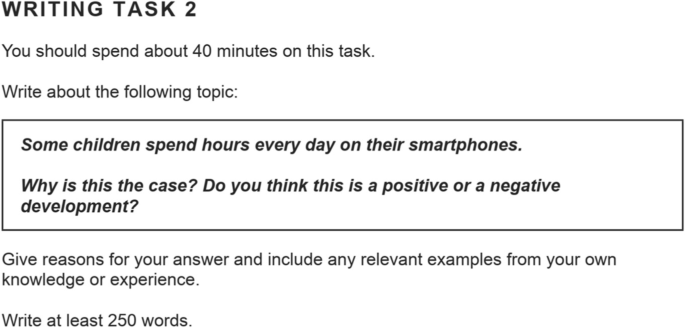
The pretest question
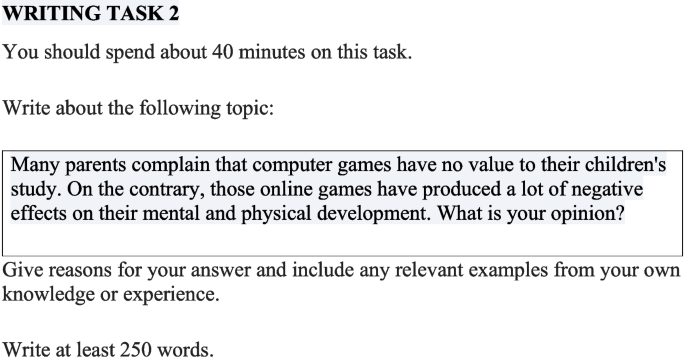
The posttest question
The treatment
The control group received regular training using teacher feedback and peer feedback, which focused on any features of essays, such as grammar, vocabulary, ideas, and organization, to improve their writing, whereas the experimental group were exposed to the method of noticing-model essays. Both groups practiced writing on the same essay question taken from the e-book “The Key to IELTS Writing Task 2” by Cullen ( 2020 ), one of the authors of the Cambridge IELTS book series. This e-book not only gave formal and valuable instructions on IELTS essay writing but also provided readers with native-speakers’ model essays. The experimental group were given the model essays from this e-book as well as the ones from the book “High-scoring IELTS Writing–Model Answers” (Fang & Wang, 2012 ) to maximize their exposure to experts’ writing.
The interview
Five random participants from the experimental group were invited for the semi-structured interview, which was useful for making the interviewees feel at ease and sharing their ideas (Creswell & Creswell, 2017 ). There were six open-ended questions as fixed items on which follow-up questions could be based when necessary. Each interview lasted for about 5 min, and all were audio-recorded with the agreement of the participants. The language used was Vietnamese, the students’ L1, to avoid misunderstanding or ambiguity (Appendix 2 ).
The data collection stage took place within a 9-day time span. On day 1, all of the participants were given detailed information on the four criteria of IELTS task 2 writing and the rubrics (in Vietnamese to avoid misunderstanding) used to mark their writing before taking the pretest. On day 3 (days 2 and 4 were spent on the listening-speaking skills), they were asked to write an essay in response to a given question. Then, while the control group reviewed their friends’ essays and gave feedback before handing the papers with comments to their teacher for further evaluation, the experimental group were provided with two model essays from experts, taken from the e-book by Cullen ( 2020 ) and the book by Fang and Wang ( 2012 ), and asked to underline the parts they think were interesting or useful. Then, the students in the experimental group worked in pairs or groups of three and discussed with their partners what and why they thought were helpful in the model essays as well as how they could improve their original writing. During students’ discussions, the teacher went around the class and offered support to those with inquiries. On day 5, both groups were required to revise their essays based on the feedback (control group) or the model essays (experimental group). On day 8, all of the participants took the posttest and handed their papers to the teachers. On day 9, the researchers invited five students from the experimental group to join the semi-structured interview. The whole procedure could be summarized as follows (Table 1 ).
Data analysis
The scores in the pretest and posttest were all analyzed in SPSS version 27 (Statistical Packages for Social Sciences). First, Shapiro-Wilk tests were run in order to examine the distribution of data; the results for pretest and posttest scores were presented in the following table (TR = task response, LR = lexical resources, GR = grammatical range and accuracy, CC = cohesion and coherence, OV = overall).
Tables 2 and 3 revealed that all of the scores in the pretest and posttest were not normally distributed (all the p values being under .01). Consequently, non-parametric tests were employed instead of t tests. Specifically, the Wilcoxon signed-rank tests were run to compare the participants’ performances between the pretest and posttest in each group, and the Mann-Whitney U tests were run to assess the results between the control group and the experimental group.
The interviews were analyzed based on the six-step strategy for qualitative data analysis proposed by Creswell and Creswell ( 2017 ). In particular, the researchers listened to the recordings carefully and transcribed verbatim. Afterwards, the researchers worked together to identify keywords, put them into codes, group the codes into categories, and combine them into two general themes. The results from the interview were used to explain quantitative outcomes from the non-parametric tests. The procedure is illustrated in the following model (Creswell & Creswell, 2017 ) (Fig. 3 ).
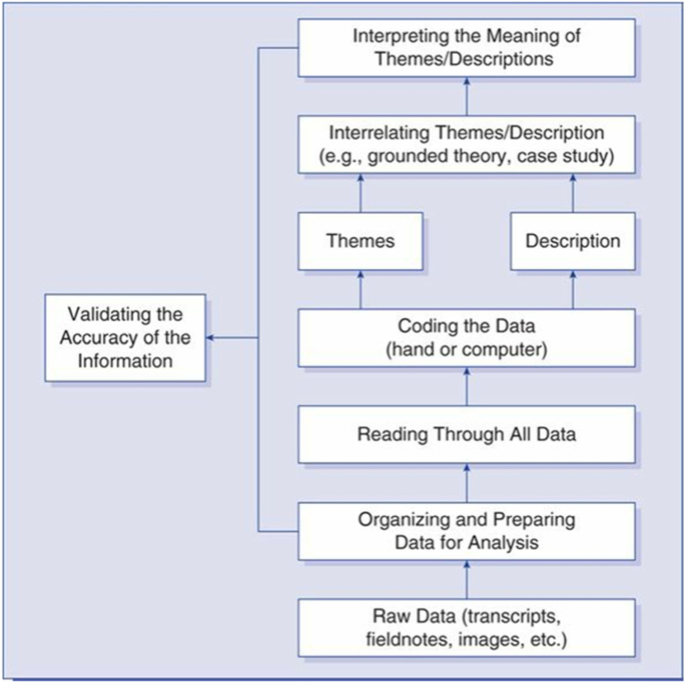
The 6-step strategy for qualitative data analysis by Creswell and Creswell ( 2017 )
Descriptive statistics
Tables 4 and 5 showed the descriptive statistics for the pretest and the posttest (values of Mean, SD, and 95% CI). It could be seen that the overall scores of the two groups ranged from 4.98 (B1, CEFR) to 5.41 (B2, CEFR) (IELTS in CEFR scale, n.d.). However, whether these changes were significant or not needed to be examined via the non-parametric tests.
Research question 1: Does using noticing-model essays as a kind of feedback improve L2 learners’ overall scores in IELTS task 2 writing more than the conventional instructional method?
As can be seen from Table 6 , there was no significant difference in the pretest and posttest overall scores of the control group ( Z = − .943, p = .346). In contrast, the experimental group achieved a significantly higher overall score in the posttest than in the pretest (mean difference = .29, Z = − 3.694, p < .001). As for the comparisons between the two groups, the Mann-Whitney U tests showed that although there was no significant difference in the overall scores in the pretest ( U = 317.5, p = .699), the results in the posttest were significantly different (mean difference = − .43, U = 203, p < .001). Therefore, it could be concluded that using model essays with the noticing technique was more effective at improving L2 learners’ overall scores in IELTS task 2 writing than the conventional instructional method, which is demonstrated below (Fig. 4 ).
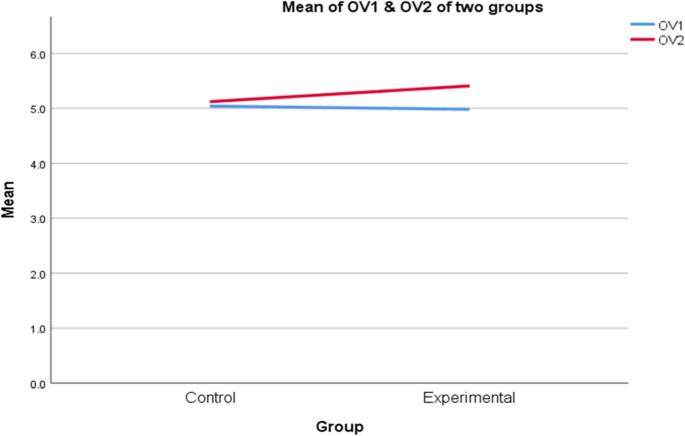
Comparisons of overall scores between two groups. OV1: overall scores in the pretest. OV2: overall scores in the posttest
Research question 2: Does using noticing-model essays as a kind of feedback improve L2 learners’ scores in the four marking criteria of IELTS task 2 writing more than the conventional instructional method?
Task response criterion
According to Table 7 , it is obvious that there were no significant differences in the pretest and posttest scores of the task response criterion, either within or between the groups (all p values above .05). In other words, all of the participants were not able to improve their content-related aspects. It was also noticeable that those in the experimental group gained lower scores (mean difference = − .11), albeit insignificant, in the posttest than in the pretest.
Lexical resources criterion
Table 8 shows that despite the insignificant difference in the scores of lexical resources in the pretest between the two groups ( U = 315.5, p = .620), the control group gained significantly lower outcomes than the experimental group in the posttest (mean difference = − .45, U = 220, p = .017). In addition, while the experimental group considerably improved their lexical use (mean difference = .45, Z = − 2.585, p = .01), the control group made no significant improvement ( Z = 0.483, p = .629).
It could be inferred from Table 9 that learners in the experimental group significantly improved their grammatical use after the treatment (mean difference = .33, Z = − 2.585, p = .01), but those in the control group did not (mean difference = .01, Z = − .783, p = .434). However, when comparing the results in grammatical range and accuracy, the Mann-Whitney U tests revealed that there were no significant differences between the two groups, either in the pretest or the posttest, although the mean difference was greater in the posttest (− .44) than in the pretest (− .12).
Similar to the results of the task response criterion, Table 10 demonstrates that there were no significant differences in the cohesion and coherence scores within each group and between the two groups (all the p values greater than .05). In other words, no considerable improvements were made in the two groups after the treatment.
In brief, through the detailed analyses, it is evident that using the noticing-model essays method significantly enhanced learners’ lexical resources while no considerable changes were observed in the task response and cohesion-coherence criteria. As for the grammatical range and accuracy aspect, although the treatment helped the participants somewhat improve their scores, this difference was statistically insignificant compared to the conventional method. A summary was demonstrated as follows (Fig. 5 ).
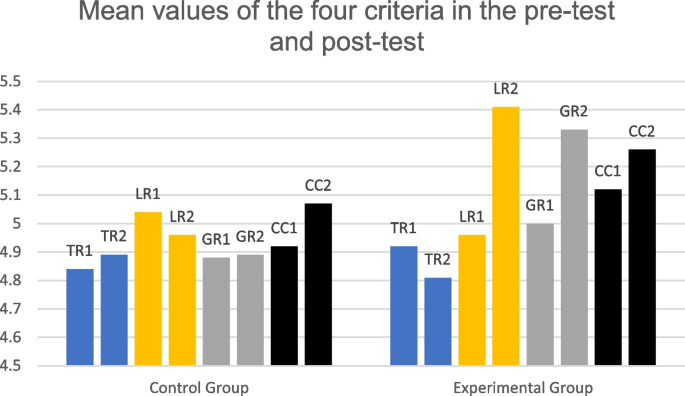
Comparisons of scores in the four criteria. TR = task response, LR = lexical resources. GR = grammatical and accuracy, CC = cohesion and coherence. 1 = pretest, 2 = posttest
Qualitative findings
After the interview data were analyzed, they were grouped into two general themes: positivity and negativity.
When asked whether learning from model essays and noticing aided their IELTS task 2 writing, all of the interviewees ( n = 5) agreed that they acquired a variety of useful expressions and terms that they previously did not know. They also tried to use the newly learned words in their posttest essays, which could be demonstrated via the sharings of participant 2 and participant 4:
“When I read the model essays, I realized that the authors and I had some similar ideas. But they expressed those ideas briefly yet still very correctly. I tried to memorize those expressions for my writing later.” (participant 2)
Agreeing with this viewpoint, participant 4 said, “I usually use repeated words in my essay, but after reading the model essays on the same topic, I knew some more synonyms and the ways to avoid repetition.” (participant 4)
Another positive feedback from the interviewees was that 80% ( n = 4) favored this kind of learning as they were given the opportunity to practice writing in the way native speakers often did. Participant 3 highlighted this quite clearly, “In my previous class, the teacher gave a lot of feedback by circling all the mistakes and giving so many comments. It was too much for me to know how to fix all the mistakes. When I read the model essays, I know how to correct my mistakes because the answers are there, in the native-speakers’ essays.” Sharing the same view, Participant 5 said, “I like learning from the model essays because I can use them as tools to improve my writing, especially vocabulary.”
Despite the favorable opinions, there were still several problems that the interviewees faced when using the noticing-model essays method. Sixty percent ( n = 3) of the participants claimed that they did not have time to pay close attention to grammar, ideas, or organization because they focused too much on how to use the words from the model essays in their posttest. Participant 1 shared, “I was so eager to use the new vocabulary in my essay, so I spent a lot of time on this part. Then I had to rush to finish my writing. So I think I did not do well in other parts.”. Seeing eye to eye with participant 1, participant 4 said, “It is hard for me to focus on many things at the same time, vocabulary, grammar, ideas, and organization. So I think the model essays are good, but it takes time”.
There was one participant (20%) who did not really like this kind of learning because it required him to work too much. Details could be found in his sharing, “I can do this for once or twice, but not for a long time. I have to read and analyze too much. I feel tired”.
In brief, most participants held a positive attitude towards the use of native models’ essays as a feedback tool because they could learn useful expressions and terms which were incorporated in their revised and new-task essays. However, since they paid more attention to lexical items, other parts, such as grammar, organization, and ideas, were mostly overlooked.
Three major findings could be drawn from the analyses of the quantitative and qualitative data. First, it was found that via the implementation of model essays and the noticing hypothesis, learners’ overall scores in IELTS task 2 writing improved statistically significantly using the conventional instructional method. This finding aligned with previous research conducted by Tieu and Baker ( 2022 ) as well as Bagheri and Zare ( 2009 ). Such considerable improvements could be attributed to the features of the noticing hypothesis per se. Schmidth ( 1983 ) and Swain ( 1985 ) argued that being able to notice native-speakers’ model expressions helped learners identify their linguistic problems and try to acquire the model versions to fill in those knowledge gaps. This process eventually turned comprehensible input, specifically negative input, into intake.
Second, the method of using noticing and model essays significantly enhanced participants’ performances in the lexical resources criterion. This was in line with past studies which reported that learners used better and more accurate lexical items after being exposed to native speakers’ models (Bagheri & Zare, 2009 ; Jafary, 2014 ; Tieu & Baker, 2022 ). The explanation was that learners paid the most attention to this aspect of the model essays, as previously proved in the study by Abe ( 2009 ). Data from the semi-structured interview also showed that the participants in the experimental group spent a lot of time thinking about ways to incorporate newly learned words in their posttest. This was clearly explained by Schmidt and Frota ( 1986 ), claiming that learners who noticed the most differences between their original version and native speakers’ models would have the most gains.
The last finding was related to learners’ insignificant achievements in the other three criteria of IELTS task 2 writing, including task response, grammatical range and accuracy, and cohesion and coherence. This was in stark contrast to a recent empirical study (Tieu & Baker, 2022 ), which concluded that learners who used model essays and noticing gained significantly higher scores in these three aspects. The difference could be due to the fact that Tieu and Baker ( 2022 ) had to delay the posttest for three months under the impact of COVID-19. During that time, the participants might have been exposed to other factors, leading to significant achievements in all areas of IELTS task 2 writing. Another plausible explanation was that in this present study, as in the semi-structured interview and also in the study of Hanaoka ( 2007 ), the participants focused too much on lexical items, thereby deterring them from having sufficient time to spend on other elements like grammar, organization, and ideas. In other words, lexical resources attracted most of their attention, so little was left for the other criteria.
Several pedagogical implications can be drawn from the present study. First, teachers and institutional leaders should make a detailed plan to implement model essays in the writing training curriculum, especially IELTS task 2 writing, due to its significant benefits to learners’ achievements. As argued by Muranoi ( 2007 ), “providing learners with opportunities for producing output in language-use contexts (i.e., language models) is facilitative in developing learners’ interlanguage, especially productive skills” (pp. 76–77). Second, to maximize students’ attention, one writing session should focus on only one or two linguistic aspects (i.e., grammar, vocabulary, ideas, and organization). This is because students’ concentration and noticing are still limited, and they should practice this kind of learning gradually until they are more familiar. Finally, evaluations or feedback (either from peers or teachers) are vital to the noticing-model essays method as students need to think aloud (express) their noticing to their friends or teachers who give them confirmation on whether their use of newly learned expressions (testing hypothesis) is appropriate. In other words, teachers are recommended to offer students timely support to reinforce the acquisition obtained from model essays.
The aim of the present study was to investigate whether the combination of the noticing hypothesis and model essays made any significant difference in learners’ IELTS task 2 writing. Three major findings were generated via the employment of a mixed-methods approach, including a quasi-experiment and semi-structured interviews. First, the noticing-model essays method significantly enhanced learners’ overall scores in IELTS task 2 writing, while the conventional instructional method did not have any considerable effect on learners’ overall scores. Second, after the treatment, a participant in the experimental group gained significantly higher scores in the lexical resources criterion. Third, the other three aspects (task response, grammatical range and accuracy, and cohesion-coherence) did not witness any statistically significant changes. Several pedagogical implications were provided, including the call for the implementation of this method, the focus on only one or two linguistic areas in each writing session, and appropriate feedback or support from peers and teachers. However, there are a number of limitations that should be addressed. For one thing, as the present study only examined learners’ exposure to model essays for a short time (within 9 days), future research is recommended to measure the effect of the method for a longer time. Besides that, the theme of the question in the posttest was still similar to that in the pretest, so whether similar outcomes can be achieved if the theme is entirely different remains unknown. In addition, as learners are more likely to focus on lexical items, which lessens the effect on other writing criteria such as task response, grammatical range and accuracy, and cohesion-coherence, future studies could specifically draw students’ attention to only one or two criteria at a time to examine whether significant improvements can be made.
Availability of data and materials
All the data used in this study belong to the authors and will be shared upon reasonable request.
Abbreviations
Cohesion and coherence
Common European Framework of Reference for Languages
Control group
English as foreign language
Experimental group
English as second language
Grammatical range and accuracy
International English Language Testing System
Second language
Lexical resources
Overall score
Second language acquisition
Statistical Packages for Social Sciences
Task response
Abe, M. (2009). Noticing in comparing own essay with model essay: an exploratory study of Japanese L2 writers. The Bulletin of the Kanto-Koshin-Etsu English Language Education Society , 23 , 71–82.
Google Scholar
Allen, D., & Mills, A. (2016). The impact of second language proficiency in dyadic peer feedback. Language Teaching Research , 20 (4), 498–513.
Article Google Scholar
Ascher, A., & Saslow, J. (2022). Top notch | online placement test—all levels (24 months) . Pearson ERPI. Retrieved September 1, 2022, from https://www.pearsonerpi.com/en/elt/integrated-skills/top-notch-online-placement-test-all-levels-24-months-9780132470308
Bagheri, M. S., & Zare, M. (2009). The role of using IELTS model essays in improving learners’ writing and their awareness of writing features. Journal of English Language Studies , 1 (1), 115–130.
Baleghizadeh, S., & Arab, F. (2011). Comparing native models and peer feedback in promoting noticing through written output. Innovation in Language Learning and Teaching , 5 (1), 63–79.
Creswell, J. W., & Creswell, J. D. (2017). Research design: qualitative, quantitative, and mixed methods approaches. Sage Publications.
Cullen, P. (2020). The key to IELTS writing task 2 . Cullen Education - Key to IELTS. https://keytoielts.com/the-key-to-ielts-success-2/
Eschholz, P. A. (1980). The prose models approach: using products in the process. Eight Approaches to Teaching Composition , 5 , 21–36.
Fang, T., & Wang, D. F. (2012). High-scoring IELTS writing model answers (Based on past papers) . Nhân trí Việt.
Faul, F., Erdfelder, E., Buchner, A., & Lang, A.-G. (2009). Statistical power analyses using G* Power 3.1: tests for correlation and regression analyses. Behavior Research Methods , 41 (4), 1149–1160.
Hanaoka, O. (2006). Exploring the role of models in promoting noticing in L2 writing. JACET Bulletin , 42 , 1–13.
Hanaoka, O. (2007). Output, noticing, and learning: An investigation into the role of spontaneous attention to form in a four-stage writing task. Language Teaching Research , 11 (4), 459–479.
Hanaoka, O., & Izumi, S. (2012). Noticing and uptake: addressing pre-articulated covert problems in L2 writing. Journal of Second Language Writing , 21 (4), 332–347.
Hentasmaka, D., & Cahyono, B. Y. (2021). Peer feedback uptakes and outcomes across EFL students’ proficiency levels: a study at tertiary education in Indonesia. International Journal of Instruction , 14 (3), 271–286.
Hyland, K., & Hyland, F. (2006). Feedback on second language students’ writing. Language Teaching , 39 (2), 83–101.
IELTS Academic 17 . (2022). Cambridge University Press.
Izumi, S., Bigelow, M., Fujiwara, M., & Fearnow, S. (1999). Testing the output hypothesis: Effects of output on noticing and second language acquisition. Studies in Second Language Acquisition , 21 (3), 421–452.
Jafary, M. (2014). Effects of model essays on the improvement of Iranian IELTS candidates’ writing ability. Doctoral dissertation, Universiti Putra Malaysia.
Khezrlou, S. (2021). Focus on form in task repetition through oral and written task modeling. International Review of Applied Linguistics in Language Teaching. https://doi.org/10.1515/iral-2020-0125 .
Lee, I. (2003). L2 writing teachers’ perspectives, practices and problems regarding error feedback. Assessing Writing , 8 (3), 216–237.
Leow, R. P. (2018). Noticing hypothesis. The TESOL Encyclopedia of English Language Teaching , 1–6.
Long, M., & Robinson, P. (1998). Focus on form: theory, research, and practice. In C. Doughty, & J. Williams (Eds.), Focus on form in classroom second language acquisition , (pp. 15–41). Cambridge University Press.
Lynch, T. (2009). Responding to learners’ perceptions of feedback: the use of comparators in second language speaking courses. International Journal of Innovation in Language Learning and Teaching , 3 (2), 191–203.
Muranoi, H. (2007). Output practice in the L2 classroom. In R. M. DeKeyser (Ed.), Practice in a second language: perspectives from applied linguistics and cognitive psychology , (pp. 51–84). Cambridge University Press.
Chapter Google Scholar
Qi, D. S., & Lapkin, S. (2001). Exploring the role of noticing in a three-stage second language writing task. Journal of Second Language Writing , 10 (4), 277–303.
Richards, J. C., & Schmidt, R. W. (2013). Longman dictionary of language teaching and applied linguistics. Routledge.
Book Google Scholar
Rutherford, W. E., & Smith, M. S. (1985). Consciousness-raising and universal grammar. Applied Linguistics , 6 (3), 274–282.
Schmidt, R. (2001). Attention. In P. Robinson (Ed.), Cognition and second language instruction , (pp. 3–32). Cambridge University Press.
Schmidt, R., & Frota, S. (1986). Developing basic conversational ability in a second language: a case study of an adult learner of Portuguese. Talking to Learn: Conversation in Second Language Acquisition , 237 , 326.
Schmidth, R. (1983). Interaction, acculturation and the acquisition of communicative competence. Sociolinguistics and Language Acquisition , 137–174.
Smagorinsky, P. (1992a). How reading model essays affects writers. Reading/Writing Connections: Learning from Research , (pp. 160–176).
Smagorinsky, P. (1992b). Towards a civic education in a multicultural society: Ethical problems in teaching literature. English Education , 24 (4), 212–228.
Swain, M. (1985). Communicative competence: some roles of comprehensible input and comprehensible output in its development. Input in Second Language Acquisition , 15 , 165–179.
Swain, M. (1995). Three functions of output in second language learning. Principles and Practice in Applied Linguistics: Studies in Honor of HG Widdowson , (pp. 125–144).
Swain, M. (1997). The output hypothesis, focus on form and second language learning. Applying Linguistics: Insights into Language in Education , (pp. 1–21).
Swain, M. (2005). The output hypothesis: Theory and research. In Handbook of research in second language teaching and learning , (pp. 495–508). Routledge.
Swain, M., & Lapkin, S. (1995). Problems in output and the cognitive processes they generate: a step towards second language learning. Applied Linguistics , 16 (3), 371–391.
Test taker performance 2021. (n.d.). IELTS. Retrieved September 2, 2022, from https://www.ielts.org/for-researchers/test-statistics/test-taker-performance
Tieu, L., & Baker, J. R. (2022). Using model essays in conjunction with noticing as a feedback instrument in IELTS writing preparation. Innovation in Language Learning and Teaching , 1–13. https://doi.org/10.1080/17501229.2022.2049799 .
Yu, S., Lee, I., & Mak, P. (2016). Revisiting Chinese cultural issues in peer feedback in EFL writing: Insights from a multiple case study. The Asia-Pacific Education Researcher , 25 (2), 295–304.
Download references
Acknowledgements
We would like to express our deepest gratitude to the school’s management board, our colleagues and the praticipants. Without their agreements and wholehearted participation, this research could not have been conducted.
This study has not been supported by any funding agency or institution.
Author information
Authors and affiliations.
FPT University, Ho Chi Minh City, Vietnam
Long Quoc Nguyen & Ha Van Le
You can also search for this author in PubMed Google Scholar
Contributions
Conceptualization: N.L.Q. and L.H.V.; methodology, N.L.Q.; software, N.L.Q.; validation, L.H.V.; formal analysis, N.L.Q.; investigation, L.H.V.; resources, L.H.V.; data curation, N.L.Q. and L.H.V.; writing—original draft preparation, N.L.Q.; writing—review and editing, L.H.V.; visualization, N.L.Q.; supervision, L.H.V.; project administration, N.L.Q. and L.H.V. All authors have read and agreed to the published version of the manuscript.
Corresponding author
Correspondence to Long Quoc Nguyen .
Ethics declarations
Ethics approval and consent to participate.
All subjects participated voluntarily and provided their written informed consent to participate in this study. Research approval was granted by the school’s management board (463/QĐ-ĐHFPT).
Competing interests
The authors declare that they have no competing interests.
Additional information
Publisher’s note.
Springer Nature remains neutral with regard to jurisdictional claims in published maps and institutional affiliations.
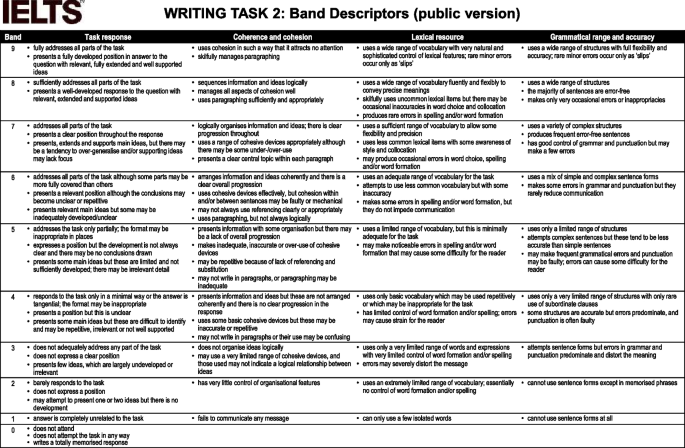
Writing rubrics
Interview questions
Do you think model essays can help you improve your vocabulary in IETLS Task 2 Writing? Please explain.
Do you think model essays can help you improve your grammar in IETLS Task 2 Writing? Please explain.
Do you think model essays can help you organize ideas in IETLS Task 2 Writing better? Please explain.
Do you think model essays can help you get better ideas for IETLS Task 2 Writing? Please explain.
What difficulties do you face when using model essays in your writing class? Please explain.
Do you like learning writing through model essays? Please explain.
Rights and permissions
Open Access This article is licensed under a Creative Commons Attribution 4.0 International License, which permits use, sharing, adaptation, distribution and reproduction in any medium or format, as long as you give appropriate credit to the original author(s) and the source, provide a link to the Creative Commons licence, and indicate if changes were made. The images or other third party material in this article are included in the article's Creative Commons licence, unless indicated otherwise in a credit line to the material. If material is not included in the article's Creative Commons licence and your intended use is not permitted by statutory regulation or exceeds the permitted use, you will need to obtain permission directly from the copyright holder. To view a copy of this licence, visit http://creativecommons.org/licenses/by/4.0/ .
Reprints and permissions
About this article
Cite this article.
Nguyen, L.Q., Le, H.V. Improving L2 learners’ IELTS task 2 writing: the role of model essays and noticing hypothesis. Lang Test Asia 12 , 58 (2022). https://doi.org/10.1186/s40468-022-00206-0
Download citation
Received : 14 September 2022
Accepted : 14 November 2022
Published : 12 December 2022
DOI : https://doi.org/10.1186/s40468-022-00206-0
Share this article
Anyone you share the following link with will be able to read this content:
Sorry, a shareable link is not currently available for this article.
Provided by the Springer Nature SharedIt content-sharing initiative
- L2 learners
- Model essays
- Writing task 2
Free Shipping for orders over RM70 (WM) & RM250 (EM)
- RM Malaysian Ringgit MYR
- $ US Dollar USD
- FREE SHIPPING: RM70 & above for WM; RM250 & above for EM
- Corporate Services
- Business Partners
- Baby & Toys
- Back to School
- Bahan Ulangkaji UASA
- Best Express Bangi
- Bundling Set
- Business Account (Landing page)
- Buy & Win
- Christmas Sale
- Corporate Sales
- Corporate Training
- Discover Your Next Favorite Book at Pelangi Books Store Shop
- Jualan Jalan-Jalan 3.0 @ Info
- Jualan Jalan-Jalan 3.0 @ Pelangi Online
- Kindergarden Operator
- Latest Release
- Persona Buku Pelangi
- Product Tab Latest Release
- Promotions of the Month
- Sticker Playland Contest
- Students/Parents
- Teaching & Learning Resources
- The Big 59 Sale
- Thomas and Friends Finger Puppet
- Warehouse Sale Academic
- Warehouse Sale Children
- Warehouse Sale Hot Deals
- Warehouse Sale Tunas
- Welcome Page
- Year End Sale
Your shopping cart is empty!
- Free Shipping
- Tingkatan 1-3

Success 2022 Model Essays for PT3 (ebook)
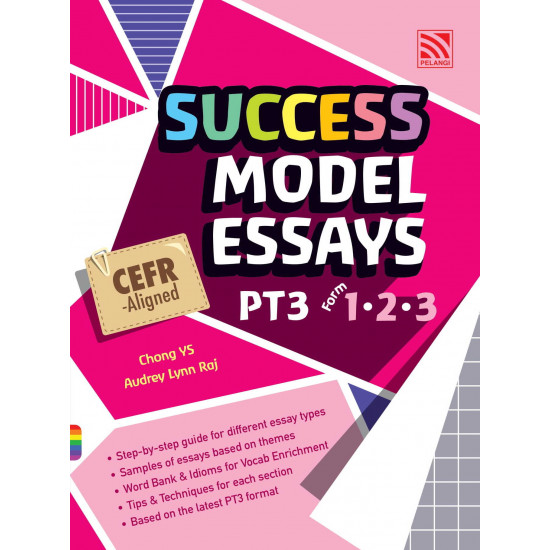
- Specifications
| esentral_book_id | 359094 |
- Stock: In Stock
- Model: 359094
- SKU: 359094
- Description
This book is designed to help pupils improve their writing skills. From the interpretation of the question to the planning and writing process, the reader is guided step by step in essay writing. Each Model Essay illustrates the process of developing ideas into an essay by putting into practice simple yet invaluable principles of essay writing.
Write a review
People also bought.
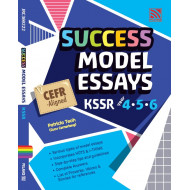
Jump to navigation
- Inside Writing
- Teacher's Guides
Student Models
- Writing Topics
- Minilessons
- Shopping Cart
- Inside Grammar
- Grammar Adventures
- CCSS Correlations
- Infographics
Student Writing Models
How do I use student models in my classroom?

When you need an example written by a student, check out our vast collection of free student models. Scroll through the list, or search for a mode of writing such as “explanatory” or “persuasive.”
Jump to . . .
Explanatory writing.
- How Much I Know About Space Explanatory Paragraph
- My Favorite Pet Explanatory Paragraph
- Sweet Spring Explanatory Paragraph
Narrative Writing
- A Happy Day Narrative Paragraph
- My Trip to Mexico Narrative Paragraph
Creative Writing
- Happy Easter Story Paragraph
- Leaf Person Story
Research Writing
- Parrots Report
- If I Were President Explanatory Paragraph
- My Dad Personal Narrative
- The Horrible Day Personal Narrative
Response to Literature
- One Great Book Book Review
- A Fable Story
- Ant Poem Poem
- The Missing Coin Story
- Winter Words Poem
- Horses Report
- Ladybugs Report
- How to Make Boiled Eggs How-To
Persuasive Writing
- Plastic, Paper, or Cloth? Persuasive Paragraph
- The Funny Dance Personal Narrative
- The Sled Run Personal Narrative
- Hello, Spring! Poem
- Cheetahs Report
Business Writing
- Dear Ms. Nathan Email
- My Favorite Place to Go Description
- My Mother Personal Essay
- Rules Personal Essay
- Shadow Fort Description
- Adopting a Pet from the Pound Editorial
- Letter to the Editor Letter to the Editor
- Ann Personal Narrative
- Grandpa, Chaz, and Me Personal Narrative
- Indy’s Life Story Personal Narrative
- Jet Bikes Personal Narrative
- The Day I Took the Spotlight Personal Narrative
- A Story of Survival Book Review
- Chloe’s Day Story
- Did You Ever Look At . . . Poem
- Dreams Poem
- I Am Attean Poem
- Sloppy Joes Poem
- The Civil War Poem
- The Haunted House Story
- The Terror of Kansas Story
- When I Was Upside Down Poem
- Deer Don’t Need to Flee to Stay Trouble-Free! Report
- Height-Challenged German Shepherd Report
- Friendship Definition
- What Really Matters News Feature
- Cheating in America Problem-Solution
- Hang Up and Drive Editorial
- Musical Arts Editorial
- Summer: 15 Days or 2 1/2 Months? Editorial
- A Cowboy's Journal Fictionalized Journal Entry
- Giving Life Personal Narrative
- The Great Paw Paw Personal Narrative
- The Racist Warehouse Personal Narrative
- Limadastrin Poem
- The Best Little Girl in the World Book Review
- How the Stars Came to Be Story
- Linden’s Library Story
- My Backyard Poem
- The Call Poem
- I Am Latvia Research Report
- Mir Pushed the Frontier of Space Research Report
- The Aloha State Research Report
- The Incredible Egg Observation Report
- Unique Wolves Research Report
- Dear Dr. Larson Email
Personal Writing
- A Lesson to Learn Journal
- Caught in the Net Definition
- From Bed Bound to Breaking Boards News Feature
- If Only They Knew Comparison-Contrast
- Save the Elephants Cause-Effect
- Student Entrepreneur Reaches for Dreams of the Sky News Feature
- Internet Plagiarism Problem-Solution
- Mosquito Madness Pet Peeve
- Anticipating the Dream Personal Narrative
- Huddling Together Personal Narrative
- H’s Hickory Chips Personal Narrative
- It’s a Boy! Personal Narrative
- My Greatest Instrument Personal Narrative
- Snapshots Personal Narrative
- Take Me to Casablanca Personal Narrative
- The Boy with Chris Pine Blue Eyes Personal Narrative
- The Climb Personal Narrative
- The House on Medford Avenue Personal Narrative
- Adam’s Train of Ghosts Music Review
- Diary of Gaspard Fictionalized Journal Entry
- My Interpretation of The Joy Luck Club Literary Analysis
- Mama’s Stitches Poem
- The KHS Press Play
- Rosa Parks Research Report
- The Killer Bean Research Report
- Mid-Project Report on History Paper Email
- Vegetarian Lunch Options at Bay High Email

- Classroom Programme
- Interview Guidance
- Online Programme
- Drishti Store
- My Bookmarks
- My Progress
- Change Password
- From The Editor's Desk
- How To Use The New Website
- Help Centre
Achievers Corner
- Topper's Interview
- About Civil Services
- UPSC Prelims Syllabus
- GS Prelims Strategy
- Prelims Analysis
- GS Paper-I (Year Wise)
- GS Paper-I (Subject Wise)
- CSAT Strategy
- Previous Years Papers
- Practice Quiz
- Weekly Revision MCQs
- 60 Steps To Prelims
- Prelims Refresher Programme 2020
Mains & Interview
- Mains GS Syllabus
- Mains GS Strategy
- Mains Answer Writing Practice
- Essay Strategy
- Fodder For Essay
- Model Essays
- Drishti Essay Competition
- Ethics Strategy
- Ethics Case Studies
- Ethics Discussion
- Ethics Previous Years Q&As
- Papers By Years
- Papers By Subject
- Be MAINS Ready
- Awake Mains Examination 2020
- Interview Strategy
- Interview Guidance Programme
Current Affairs
- Daily News & Editorial
- Daily CA MCQs
- Sansad TV Discussions
- Monthly CA Consolidation
- Monthly Editorial Consolidation
- Monthly MCQ Consolidation
Drishti Specials
- To The Point
- Important Institutions
- Learning Through Maps
- PRS Capsule
- Summary Of Reports
- Gist Of Economic Survey
Study Material
- NCERT Books
- NIOS Study Material
- IGNOU Study Material
- Yojana & Kurukshetra
- Chhatisgarh
- Uttar Pradesh
- Madhya Pradesh
Test Series
- UPSC Prelims Test Series
- UPSC Mains Test Series
- UPPCS Prelims Test Series
- UPPCS Mains Test Series
- BPSC Prelims Test Series
- RAS/RTS Prelims Test Series
- Daily Editorial Analysis
- YouTube PDF Downloads
- Strategy By Toppers
- Ethics - Definition & Concepts
- Mastering Mains Answer Writing
- Places in News
- UPSC Mock Interview
- PCS Mock Interview
- Interview Insights
- Prelims 2019
- Product Promos

Destiny of a Nation is Shaped in its Classrooms
- 27 Jun 2024
Impact of the New Economic Measures on Fiscal Ties Between the...
- 21 Jun 2024
The Character of An Institution is Reflected in Its Leader
- 13 Jun 2024
Farming has Lost the Ability to be a Source of Subsistence for...
- 06 Jun 2024
Reality does not Conform to the Ideal, but Confirms It
- 31 May 2024
A People that Values Its Privileges Above Its Principles Loses...
- 23 May 2024
The Past is a Permanent Dimension of Human Consciousness and V...
- 16 May 2024
Customary Morality cannot be a Guide to Modern Life
- 10 May 2024
Management of Indian Border Disputes - A Complex Task
- 02 May 2024
Poverty Anywhere is a Threat to Prosperity Everywhere
- 24 Apr 2024
A Good Life is One Inspired by Love and Guided by Knowledge
- 18 Apr 2024
Alternative Technologies for a Climate Change Resilient India
- 12 Apr 2024
Rise of Artificial Intelligence: The Threat of Jobless Future ...
- 04 Apr 2024
Biased Media is a Real Threat to Indian Democracy
- 29 Mar 2024
Neglect of Primary Health Care and Education in India are Reas...
- 18 Mar 2024
Best for an Individual is not Necessarily Best for The Society
- 08 Mar 2024
Values Are Not What Humanity Is, But What Humanity Ought To Be
- 01 Mar 2024
Courage to Accept and Dedication to Improve are Two Keys to Su...
- 14 Feb 2024
Wisdom Finds Truth
- 07 Feb 2024
South Asian Societies are Woven not Around The State, but Arou...
- 30 Jan 2024

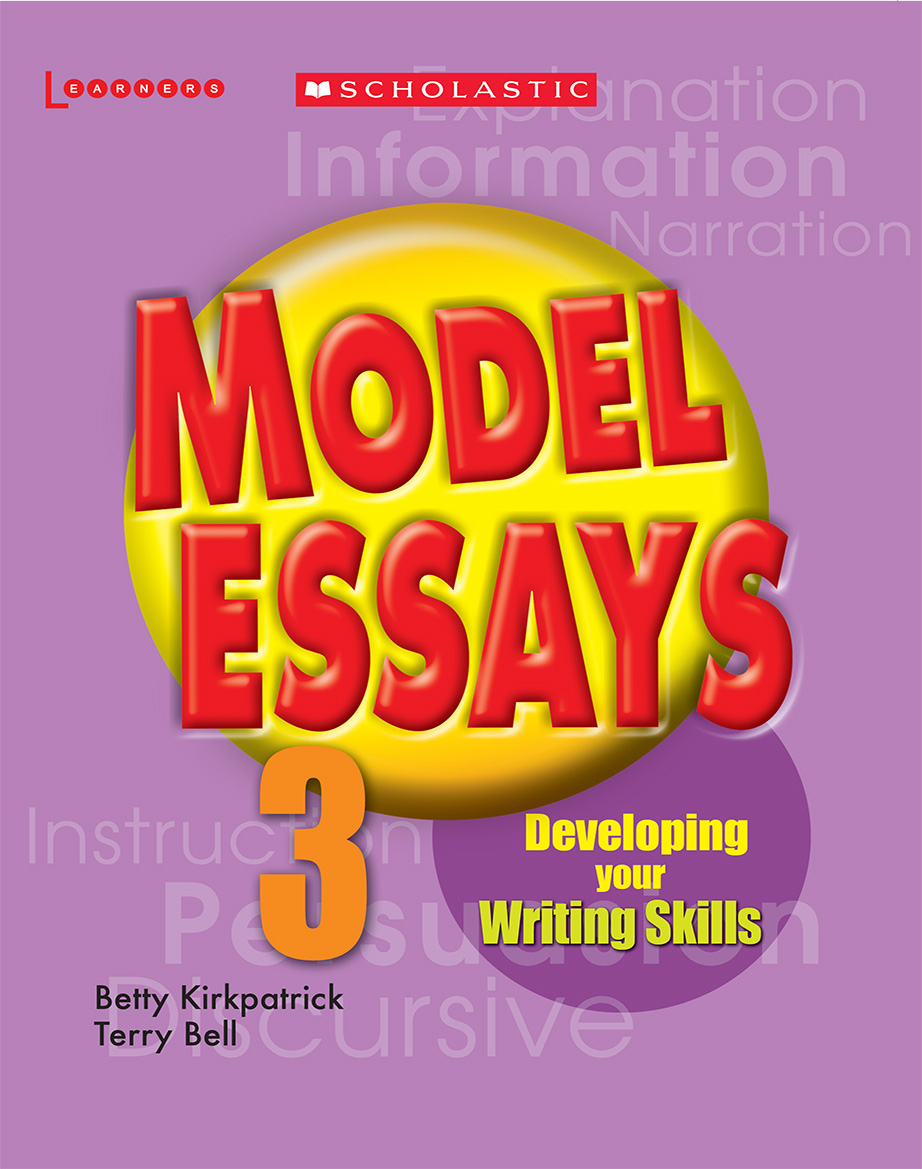
- Privacy Policy
- Terms of Use
TM & © 2024 Scholastic.Ltd./ Inc. All Rights Reserved.
TM&(c)2022 Scholastic Inc.すべての権利を保有します。
TM & (c) 2022 Scholastic Inc. 판권 소유.
Share to - WeChat
Not a member yet? Register
Forgot password?

IMAGES
VIDEO
COMMENTS
IELTS. Practise 3 Types Of Writing with Answers & Model Essays<br><br>IELTS Writing (Academic)<br>IELTS tests candidates' ability to produce two quite different pieces of writing in a fairly short period of time. The test is divided into two parts and candidates are allowed 60 minutes to complete both parts.<br>IELTS Writing Task 1<br>In the first part, candidates will be given a task based ...
ВКонтакте - универсальное средство для общения и поиска друзей и одноклассников, которым ежедневно пользуются десятки миллионов человек. Мы хотим, чтобы друзья, однокурсники, одноклассники, соседи и коллеги всегда ...
Great Writing | Level: 3<br><br>Publisher: National Geographic, Cengage Learning<br><br>Now with engaging National Geographic images, the new edition of the Great Writing series helps students write better sentences, paragraphs, and essays. The new Foundations level meets the needs of low-level learners through practice in basic grammar, vocabulary, and spelling, while all levels feature clear ...
Model Essays 3. . About The Book/Series. Model Essays allows learners to acquire ideas, techniques and knowledge of common composition topics by reading and studying well-written essays. Key Features: • Wide range of topics and text types with description of text structure. • Vocabulary section explains meaning of difficult ...
This is a series of 3 books designed to demonstrate to students how well-written essays are structured. In reading and studying the model essays, students will acquire ideas and facts related to the topics. They will also become familiar with the techniques of writing interesting essays. After each essay, there is a vocabulary section that explains the meanings of some difficult words in the ...
Model essays can be extremely useful because they show you what you are aiming for, and they contain good vocabulary and correct grammar. However, the model essays in some IELTS books seem to confuse students because they are written in too many different ways (so the 'method' isn't clear). Although there is no 'right way' to write an essay, I think that you should find one way and stick with ...
Model Essays 3, Developing your writing skills, Betty Kirkpatrick, Terry Bell Đây là bộ sách gồm 3 cuốn được biên soạn nhằm giúp người học hiểu cách bố cục một bài văn hay. Qua việc đọc và phân tích các bài luận mẫu, học viên sẽ có được ý tưởng và thông tin
Model Essays (trọn bộ) Bộ sách luyện viết gồm 3 tập rất hay với các phần hướng dẫn bạn tập viết các bài luận từ cơ bản đến nâng cao, viết đúng ngữ pháp rất hữu ích cho Giáo viên và Học sinh. Đây cũng là bộ sách gợi ý cho các Học sinh luyện phần thi Viết trên ...
Paperback : 288 pages. ISBN-10 : 0321923731. ISBN-13 : 978-0321923738. Item Weight : 12.8 ounces. Dimensions : 5.5 x 0.7 x 8.5 inches. Best Sellers Rank: #7,226,811 in Books ( See Top 100 in Books) #3,116 in Creative Writing & Composition. #20,935 in Fiction Writing Reference (Books) #384,364 in Unknown.
Model essay 2.pdf - Free ebook download as PDF File (.pdf) or read book online for free.
Though aimed at Form 1 - Form 3 students, this book is also. suitable for anyone who wants to write well. W.M: RM18.95 / E.M: RM18.95. JC107220. ISBN: 978-967-2353-16-4. View flipping ebook version of WRITE IT RIGHT 2020 MODEL ESSAYS FOR PT3 published by PENERBITAN PELANGI SDN BHD on 2021-06-24.
High-scoring IELTS Writing Model Answers <br> <br>1. Selected IELTS actual tests <br>This book has 79 test questions in total, carefully selected from nearly 100 actual test questions to represent test trends and the accurate level of difficulty in recent years. <br> <br>2. Model essays from experienced teachers <br>All model essays in this book were written by our most experienced teachers ...
Achieving a sufficient IELTS band score for academic purposes has been a major goal of many L2 learners around the world, especially those in Asia. However, IELTS writing scores were consistently reported to be the lowest when compared to the scores in speaking, reading, and listening. Despite a growing body of research in IELTS writing, little focused on the role of model essays and noticing ...
RM15.90. Add to Cart. Description. Reviews. This book is designed to help pupils improve their writing skills. From the interpretation of the question to the planning and writing process, the reader is guided step by step in essay writing. Each Model Essay illustrates the process of developing ideas into an essay by putting into practice simple ...
M. Lashley Communication Studies 2012-2013 Model Essay Module 3 - Speaking Speaking and Writing You are a member of the Abstinence Club in your high school. You are concerned about the small numbers of students that attend your weekly meetings. You have been asked to organize organize a campaign tthat hat would convince students students to ...
IELTS Writing Task 2 Tips and Sample Essays. 10 авг 2017. #Tips. -Use the question to help you organize your answer. -Check the general topic of the question, usually, a problem, a point of view or a statement with two opposing views. -Check how many parts there are to the question.
Student Models. When you need an example written by a student, check out our vast collection of free student models. Scroll through the list, or search for a mode of writing such as "explanatory" or "persuasive.".
Reach Us 12, Main AB Road, Bhawar Kuan, Indore, Madhya Pradesh, 452007 641, 1 st Floor, Mukherjee Nagar, Delhi-110009 ; 21, Pusa Rd, WEA, Karol Bagh, Delhi-110005
Model Essays 3 | Scholastic International. Browse the best children's books, series, authors and specially curated booklists. Explore the extensive collection of reading programs, digital products and learning resources. Innovative educational resources and authentic literature to use with the best children's books.
Questions about Model Essay 3 . What is the topic of this essay? What are its subtopics? Write each subtopic in the outline below. Write an appropriate thesis statement for this essay: Fill in the following outline and write a suitable introduction for this essay titled Don't Expel Them. Make sure it is at least 5-8 sentences.
IELTS Writing Task 2: a model essay. Today I want to share an essay so good that I don't know how it can possibly be improved. The essay was written by my incredible, perseverent, writing-loving student and a wonderful English teacher Nina Kovba, who is now preparing for IELTS and who is definitely on track for a very high score.
From the graph I can say how much energy …. Model answer. Page 10 of 108. The graph shows consumption of energy in the U.S. since 1980 with projections through 2030. The historical trends showPetrol and Oil as the major sources of fuel, rising from 35 quadrillion (35q) units used in 1980 to 42q in 2012.
Essays & Writing Assignments Done for You Get help with any kind of assignment - from a high school essay to a PhD dissertation